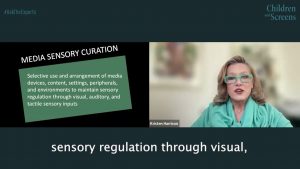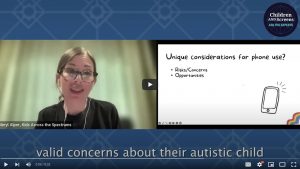
Kristen Harrison, PhD (Richard Cole Eminent Professor, Hussman School of Journalism and Media, University of North Carolina), translates the academic definition of media sensory curation into less technical terms and explains why neurodivergent youth may use media devices as tools to manage uncomfortable sensory inputs in #AskTheExperts webinar “Nurturing the Neurodivergent: Unique Considerations for Youth Screen Use” on February 6, 2024.
Read the Video Transcript
[Dr. Kristen Harrison]: In my lab, my students and I define media sensory curation as in this academic way: selective use and arrangement of media devices, content, settings, peripherals, and environments to maintain sensory regulation through visual, auditory, and tactile sensory inputs. In less technical terms, you can think of high sensory curation as the media equivalent of picky eating. High sensory curators are very particular about their media arrangements. Now the ideas behind, or the idea behind sensory curation is that media can reduce the discomfort of dysregulating environments, those that are too intense or, conversely, boring. Remember that adults decide where children eat, sleep, learn, and play. The ability to use media devices as tools to manage sensory input should be especially appealing to people for whom the built environment was not normed, like kids whose neurodivergence involves sensory challenges. So let me give you a visual example of sensory curation. Here we have a photo of Katz’s Delicatessen in New York, those of a certain age are going to know it as the location of a certain famous scene in the movie “When Harry Met Sally.” Imagine being a sensitive kid in this environment, the clashing sounds, the visual clutter, the smells of different foods, the experience of being jostled in a crowded room. Now imagine that you can replace at least some of that unsettling sensory input with something more settling and predictable. Behold, the beautifully regular motion paths and soothing music of Minecraft, blocking out most of the noise and visual chaos. It’s tempting to judge kids and their parents when the kids use media in public, but maybe this portable sensory modification tool, the little screen device, is actually the thing that’s enabling them to survive the meal with their family in an environment that was not comfortable or is not comfortable for them.
View the full webinar

Nurturing the Neurodivergent: Unique Considerations for Youth Screen Use
What should parents and caregivers know about the unique risks and opportunities for neurodivergent youth when introducing and monitoring the use of digital media?
Meryl Alper, PhD
Associate Professor of Communication Studies, Northeastern University
Abigail Phillips, MLIS, SLIS, PhD
Assistant Professor, School of Information Studies, University of Wisconsin-Milwaukee
Annuska Zolyomi, PhD
Assistant Professor of Computing and Software Systems, University of Washington Bothell
Kristen Harrison, PhD
Richard Cole Eminent Professor, Hussman School of Journalism and Media, University of North Carolina
LaChan Hannon, PhD
Director of Teacher Preparation and Innovation, Department of Urban Education, Rutgers University Newark; Co-founder, Greater Expectations Teaching and Advocacy Center Inc



